Food in Iron Age Finland - Summary
© Satu Hovi 1998 / 2017
No part of this text is allowed to be cited or published without my permission. Please note that methods of research get better all the time, and new interpretations may appear.
Drinks
Everyday drinks were fermented by leaven of bread (Uusivirta). Sour milk was also a normal everyday drink (Uusivirta, Genrup). According to Finnish folk tradition there is two different ways to make it. Some plants can turn the milk sour (Israelsson, Rautavaara). From Kalevala we know that at feasts fine drinks were drank. There were mead, flavoured by certain herbs known from Swedish finds (Thunaeus). Surely some kind of fermented berry wines were available, because they are so simple to make. From England we know many different mixtures of drinks (Hagen, Bergen). Beer and drinks were spiced with many herbs (Rautavaara). Hop grew here, but it was maybe made mostly into textiles (Swahn) or young plants were eaten in stew.
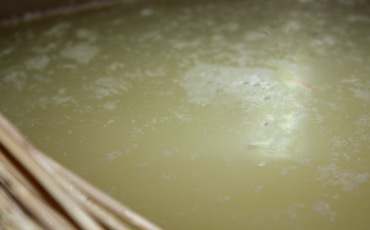
Eggs
Eggs of wild birds were gathered. Birds were encouraged to lay eggs by building places for birds to lay eggs (Uusivirta). Israelsson writes that people grew poultry in Sweden, also in England (Hagen).
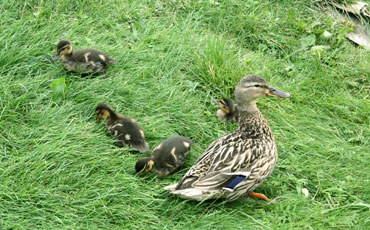
Fruits and berries
The only fruit was wild apple, which was more common than nowadays. A variety of fruits we eat today were grown in roman and southern European gardens, but they were unlikely seen here, maybe not even heard of. We had a huge variety of wild berries in the forests and undoubtly we used it. Wild currant also grew in Finland in that time. We also had wild roses and raspberries to collect (Rousi).
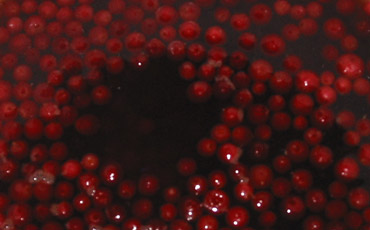
Vegetables
In iron-age Finland people harvested only turnip, peas and broad bean, which is an ancient variety of green bean. No cabbage was known here, though it was the basic food of Scandinavian Vikings. Why Finns did not know cabbage, is mysterious, but it is supposed to be so.
People cooked vegetables by stewing in a hole in the ground, cooking in ashes or by cooking. Preservation was made either drying or - a surprise - by souring. They may have eaten vegetables raw. The leaves of a turnip are also edible. These were probably a wanted adding to soups and stews.
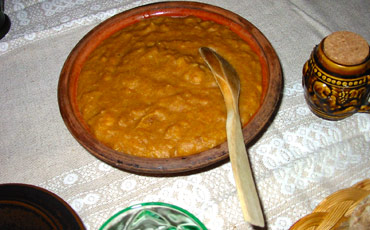
Wild spices
Salt was made on the coasts of the Ice sea in the Middle Ages. I suppose it was a luxury item in the Iron Age and people used herbs from nature to replace it or / and increase preservation. Whether people wanted to use herbs for taste, as spices, we do not know. Some personalities liked variety already on those days for sure. Luxury imported spices were not known here. Very few living here used them, if any. Folk tradition tells about the spicy taste of some herbs (Rautavaara etc.). For example mustard taste can be made from wild herbs. The only onion that grows wild in Finland is, and was, ramsons (Allium schoenoprasum).
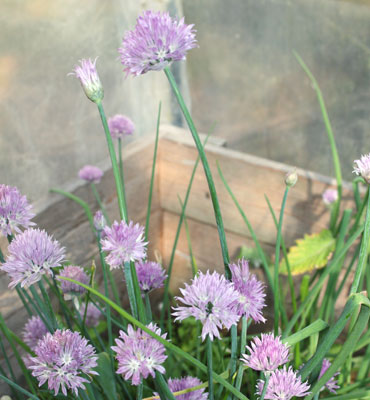
Dairy products
All the milk was made into cheese or sour milk Uusivirta writes that people in ancient times ate cheeses cooked from sour milk as their everyday food. For feast they cooked cheeses using eggs. To sour milk for to make cheese there are several ways; wild plants (for example nettle) and the stomach of certain animals (Uusivirta, Rautavaara, Israelsson). Traditional sour product is also quark, spaghanum. Butter was made by processing the milk by hand, since we did have no churns in Iron-Age Finland.
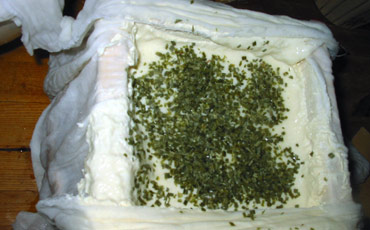
Meat and fish
It seems that meat was not rare in Viking Age Finland. People ate domesticated animals, like sheep, and wild animals. Known as a land of thousand lakes, Finns ate a lot of fish. Meat and fish were preserved by souring, smoking, drying and stored in fat. Salting was a luxury on those days.
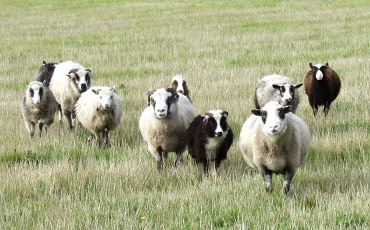
Sweets
Whether the mouth and taste of iron-age person wanted sweets, we do not know. Already from stone-age is known that people ate gum of trees (Rautavaara, Uusivirta etc.), also honey combs are some kind of chewing-gum. Honey was used a lot, at least in drinks. Whether people cooked syrups in Finland, is unknown to us. Ann Hagen writes that there is some information of cooking syrup from England. For example syrup can be made from the sap of many trees, roots of some wild plants and the tops of twigs in the spring.
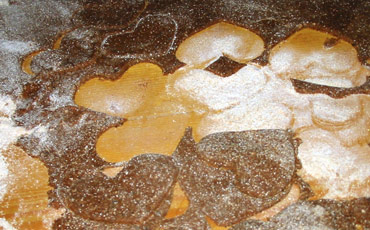
Wild plants and roots
People ate everything possible nature could get for sure. I have written in my article ”Bread and porridge in Iron-Age Finland” about some edible plants, which grew naturally in Finland at that time, and their use for food. There are more articles of wild food in these pages, too.
Bibliography
Aaltonen, Turkka & Arkko, Matti: Yrttiopas, luonnonkasvit ravintona. Suomen matkailuliitto, 1986
Berger, Christian & DuboË- Laurence. Philippe: Oluen ystävän opas.Otava
Birkebaek: Oldtiden I, Vikingatiden.
Blamey, Marjorie & Grey-Wilson, Christopher: Otavan kasvitieto. Skotlanti, 1994
Dembinska, Maria: Food and Drink in Medieval Poland. University of Pennysylvania press, 1999
Genrup, Kurt: Mat som Kultur; Etnologiska kosthållstudier. Tidskrift för nordskandinavisk etnologi vol 5, Umeå Universitet 1988
Hagen, Ann: a Handbook of Anglo-Saxon Food, Processing and Consumption. Anglo-Saxon books, 1994
Hagen, Ann: a Handbook of Anglo-Saxon food, Production & Distribution. Anglo-Saxon books, 1995
Hess, Karen: Martha Washington’s Booke of Cookery. Columbia University Press, 1981
Israelsson, Isse: Mat på forntida vis, ide och receptsamling; Malmö museer (also published in Forntida teknik 2/89-1/90 as Forntida mat)
Johansson, Tomas: Att ätä som en stenåldersjägare; Forntida Teknik
Jäntti & Olkinuora: Tähkäpää, luomuleipojan käsikirja
Kulturhistorisk lexikon för nordisk medeltid; Akademiska bokhandeln 1976
Kytövuori, Pirjo & Hopsu-Neuvonen, Arja: Kanankaalista karpaloon, luonnonruokaa keväästä syksyyn. Marttaliitto ry 1995
Lampinen: Ruokaleipä ja sen valmistus
Moberg; Min svenska historia, det dagliga barkbrödet
Namez, Milton: Searching for a Structure in the Late Iron Age Settlement of the Åland Islands, Finland, Karhunhammas 15/1993
Rautavaara, Tapio; Mihin kasvimme kelpaavat, ruokaa, ryytiä ja rohtoa luonnosta, WSOY 1976
Retkeilykasvio. Suomen luonnonsuojelun tuki oy. Helsinki, 1984
Rousi, Arne: Auringonkukasta viiniköynnökseen, ravintokasvit, WSOY 1997
Sass, Lorna: Christmas Feasts from History.The Metropolitan Museum of Art, 1981
Schöneck, Annelies: Leipä, Hermes Oy, 1983
Seppä-Heikka, Merja: Esihistoriallisia siemeniä ja kasvipainanteita Paimion Sievolan myöhäisrautakautiselta asuinpaikalta.
Simonetti, Gualtiero: Makujen maailma, yrtit ja mausteet. Kolibri, 1990
Stead, Bourke ja Brothwell: Lindow Man the Body in the Bog; British Museum Publications, 1986
Storck, John & Teague, Walter Dorwin: Flour For Man’s Bread; A History of milling. Oxford University Press, 1952
Suominen, Juha & Hämet-Ahti, Leena: Kasvistomme muinaistulokkaat, tulkintaa ja perusteluja, Vammala 1993
Thunaeus, Harald: Mjödet genom tiderna. Daedalus 1954
Tolonen, Mirjami: Cereal Cultivation with Particular Reference to Rye: Some Aspects on Pollen-analytical Records from Sw. Finland; Fennoscandia Archaelogica II, Suomen arkeologinen seura, 1985
Uusivirta, Hilkka: Suomalaisen ruokaperinteen keittokirja, WSOY 1982
Vehviläinen, Olli: Hiivan tarina
Viklund, Karin: Bröd, gröt och öl i forntiden; Aktuellt 93, Forntida teknik 1/93
Wilson, Anne C.: Food and Drink in Britain From the Stone Age to recent times.Penquin Books, 1084
Articles:
Bengtsson, Niklas: Elämän ja kuoleman eliksiirejä. HS 3.4.1997
Mannerkorpi, Jukka: Hunajaleipuri johtaa onneen; HS 3
Masonen, Jaakko: Maistui olut ennenkin. Tiede 2000 4/1992
Mausteet ehkäisevät homehtumista, Pirkka 1-2/96
Pakarinen, Aila: Kaalin hapattaminen sujuu aloittelijalta. HS
Skaarup, Bi: Sources of Medieval Cuisine in Denmark. In: Du manuscrit à la table, direct. Carole Lambert. Canada, 1992
Suomalaisille tarjotaan jälleen nälkämaan leipää; Itä-Helsingin Uutiset 27.3.1993
Tahkolahti, Jaakko: Pettu onkin terveellistä ja torjuu myös UV-säteilyn; HS 11.2.1997
Toiviainen, Lauri: Oluenpanosta todisteita jo 5000 vuoden takaa. HS 5.12.1992
Uudelleen keksitty pellava maustaa lakritsin ja sämpylän; HS 17.11.1994
HS= Helsingin Sanomat
Classes:
Vilkuna, Anna-Maija: Ruokatalous Hämeen linnassa 1500-luvulla. (Food Consumption in 16th century Häme castle) Suomen muinaismuistoyhdistys 4.12.1997
Conversations:
Linturi, Elsa. Archaeologist, University of Helsinki 1998